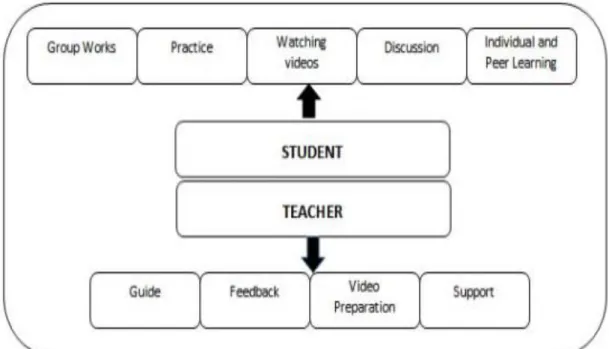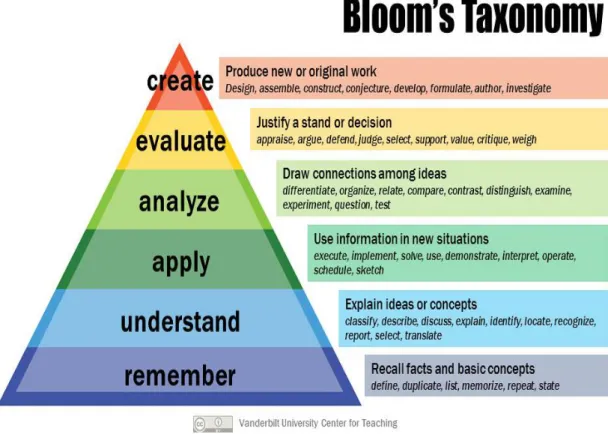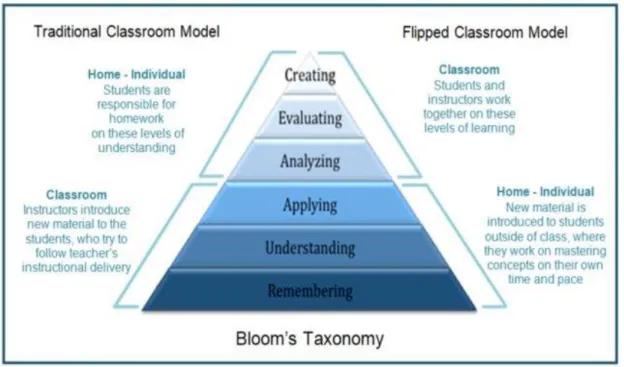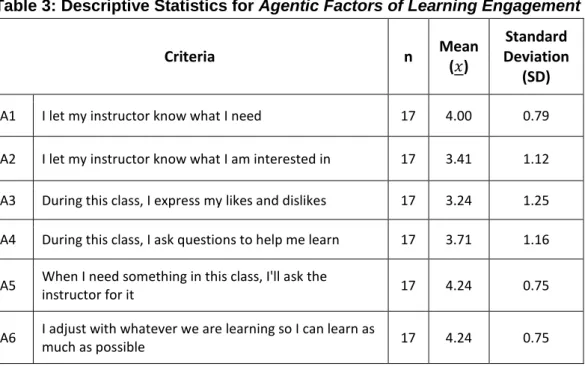The study used the Reeve's Learning Engagement Scale (LES) questionnaire as a quantitative tool to analyze students' overall engagement in terms of behavioral, emotional, cognitive, and agency constructs. The findings of this study showed overall positive engagement in learning for the identified engagement constructs and positive student perceptions of the RFC approach, with flexibility, immersive learning, autonomy and agency as the main themes emerging from the qualitative analysis.
Introduction
- Overview
- Rationale of the Research Study
- Significance of the Research Study
- Context of the Study
- Aim of the Study
- Research Objectives
Furthermore, the effectiveness of the RFC approach to assessing perceptions of the learning experience is an unexplored area. In addition, the effectiveness of the RFC approach to assessing conceptual elements of participation, such as behavioral,.
Literature Review
Flipped Learning
9 The FL approach has evolved to form several different versions (Bates et al., 2017), where the teacher can use a variety of instructional tools and methods within the context of this learning approach (FLN, 2014). The RFC approach, identified as a promising strategy for integrating active online learning (Hew et al., 2020), allows instructors to assign students online learning materials to be viewed as asynchronous learning outside of class time (Bergeman and Sam, 2012) and integrate active class discussions and group assignments during the synchronous online session.
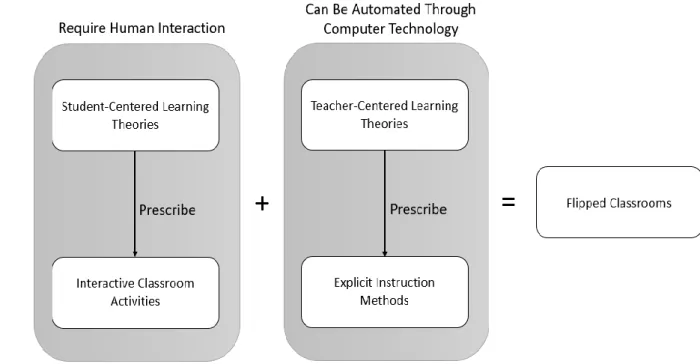
Flipped Learning Characteristics and Methodologies
In the context of higher education, Chen et al. 2014) proposed an improved model which includes the four pillars of the F-L-I-P model and includes three additional pillars;. The quality of the teaching materials, which includes the content and duration of the videos used as pre-class materials (Akçayır and Akçayır, 2018; Slemmons et al., 2018).
Theoretical Frameworks of Flipped Learning
The inclusion of meaningful activities within FL implies the adoption of student-centered active learning mechanisms (Khanova et al., 2015; Pierce and Fox, 2012), which can be defined as "a method of learning in which students are actively or experientially involved" in the learning process”. As shown in Figure 6, the social constructivist and active learning pedagogies are applied during the class session in the FC, where the instructor (the MKO) facilitates the teaching session through interactive classroom activities, such as group discussions, debates, case studies, and other team-based and/or problem-based learning opportunities.
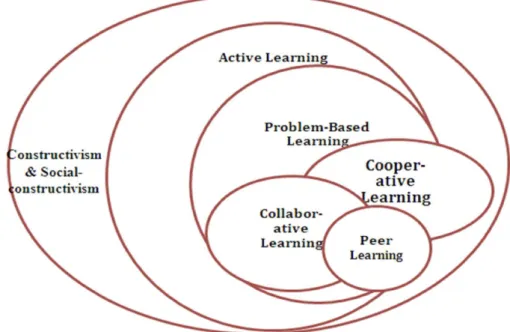
Flipped Learning Benefits, Misunderstandings and Challenges
- Benefits of the Flipped Learning approach
- Misunderstandings in the Flipped Learning Approach
- Challenges of the Flipped Learning Approach
While the FL approach allows instructional time to be reused, it has been shown to contribute to significant instructor workload, before and after in-class instruction (Ghadiri et al., 2014). This is particularly relevant in the transition phase of transforming the typical lecture-based teaching pedagogy to the FL approach (Karabulut‐Ilgu et al., 2018).
Student Engagement .1 Overview
- Conceptualization of Student Engagement Constructs
Therefore, the analysis of engagement requires a cohesive understanding of its conceptualization and the various elements that contribute to overall engagement in learning (Bond et al., 2020). Although there may not yet be a single interpretation of student engagement that meets the requirements of all stakeholders (Solomonides, 2013; Bond et al., 2020), it is widely accepted that the study of learning engagement requires the assessment of variables of different to analyze the overall contribution to engagement (Bond et al., 2020).
Reeve’s Engagement Model
Behavioral engagement can be defined as the degree to which a student shows attention and maintains a commitment to the task, making a strong and persistent effort towards the learning activity (Reeve, 2013). Emotional engagement can be defined as the degree to which a student expresses his feelings when performing the task.
Flipped Classrooms and Engagement
In addition, studies on the effectiveness of FL popularly have shown that the approach contributes to learning engagement and motivation (Bond and Bedenlier, 2019; DeLozier and Rhodes, 2017; McLaughlin et al., 2013), and positive learning perceptions and satisfaction. With regard to RFC, a recent study by Ho et al. 2020) examined the impact of RFC on the learning perception and satisfaction of Taiwanese pharmacy students.
Overview
Research Design and Methodology
The methodology of this study uses a case study design with a mixed method approach (MMCSR), as the essence of the research questions is illustrated by this design. This is where triangulation helps, as the findings of multiple qualitative data sources can be explored from different perspectives (Schoch, 2016) and converged together to build a common nexus of evidence-gathering (Yazan, 2015).
Research Questions
What are students' perceptions of RFC's approach in terms of learning and engagement. What do the instructors think of the RFC approach in terms of learning and engagement.
Sampling
What is the impact of implementing RFC on the behavioral, cognitive, emotional and agentic factors of student engagement. This is an appropriate non-probability sampling method for qualitative data in mixed method studies, since the main purpose of purposive sampling is to establish a sample that can be assumed to be representative of the majority, while emphasizing the characteristics of the population that are essential to the researcher's field of interest, facilitating the search for understanding and the justification of the research questions (Lavrakas, 2008).
Data Collection Instruments
- Questionnaire
- Interviews
The Appendix section contains details of the participant consent form (Appendix 3) and details of the interview questions (Appendix 5). The Appendix section contains verbatim transcripts of the semi-structured interview with the instructor (Appendix 8) and the focus group interview with students (Appendix 7).
Validity and Reliability
- Quantitative Data Collection
- Qualitative Data Collection
In addition, there is no under-coverage bias in the answers, as convenience sampling and no exclusion criteria are used. 40 During the interviews, the problems were taken into account in order to reduce problems with the validity and reliability of the research. According to the literature, the integration of different qualitative data sources obtained through a structured and methodical process in different phases of research provides a platform for making interpretations and arguments in the triangulation method (Mishra and Rasundram, 2017).
Data Analysis
- Quantitative Data Analysis
- Qualitative Data Analysis
Additionally, triangulation helps to validate qualitative findings and reduce potential biases implicit to any single data collection method (Cresswell, 1999), thus validating the results. In step 1, the recorded interviews were listened to and transcribed, without separating any themes in the data, so that the qualitative data collected could be viewed as a complete entity. The second step was where the process of thematic analysis began, with the researcher now assigning themes according to commonalities in the phrases used by the participants when answering the interview questions, thus allowing the data to generate meaning.
Ethical approval and Consent to Participate
In addition, to ensure reliability, method triangulation and data source triangulation were used to review the responses and rationales for the responses. During the focus group interview, participants were asked to respect the privacy of other focus group members in the consent form and prior to the interview by not disclosing any content discussed. The researcher has used pseudonyms to ensure confidentiality, privacy and anonymity of data when the responses were discussed and analyzed for themes.
Findings
Overview
Quantitative Findings
- Behavioral Factors of Learning Engagement
- Emotional Factors of Learning Engagement
- Agentic Factors of Learning Engagement
- Cognitive Factors of Learning Engagement
The descriptive statistics for the behavioral factors of learning engagement show the highest scored means (𝑥 = 4.41), for three items. For the agent factors of engagement, a set of seven items (A1 to A7) allows students to indicate their degree of agreement, as shown in Table 3. For the cognitive factors of engagement, a set of nine items (C1) is to C9) had students rate their level of agreement, as shown in Table 4.
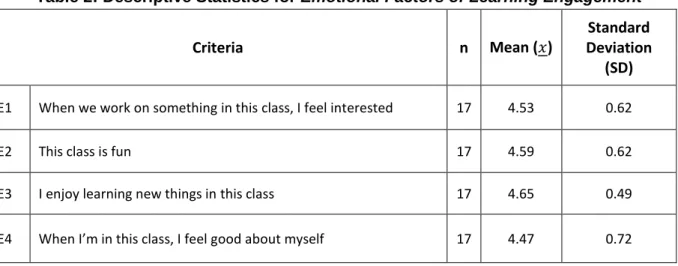
Qualitative Findings
- Student Responses
- Instructor Responses
- Extracted Codes and Themes
58 IK.3 What is your opinion about the responsibility to learn on your own during the pre-class time. IQ.6: What were some of the challenges you faced in the Flipped Learning approach? IQ.7: In terms of the improvement you see, what are your next steps if you want to consider this approach for the next term.
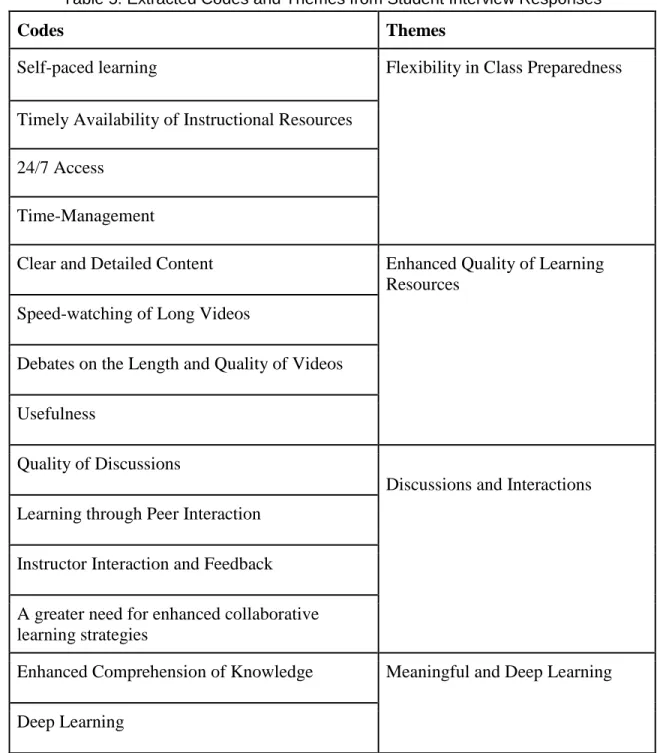
Quantitative Analysis Discussion of Student Responses .1 Discussion for Research Question 1
The MMCSR has three primary research questions and this chapter discusses and explains the findings according to the research literature. The rationale for the results in agent engagement can be linked to the instructional approach and peer collaboration during pre-class, in-class and post-class. 70 Although students' responses to express their learning preferences to the instructor showed a greater degree of variability, the results showed that students learned to adjust and adapt their learning (on their own) to make it interesting so that they can learn as much as possible .
Qualitative Analysis Discussion of Student and Instructor Responses
- Discussion for Research Question 2
- Discussion for Research Question 3
Students found that the pre-class preparation enabled them to actively participate and learn more from their peers and instructor during classroom interaction. Instructor responses indicated that few formative assessment strategies were used, such as the use of online polls during the classroom session and a quiz at the end of the classroom session. Instructor responses revealed a general annoyance at the lack of pre-class preparation, which was often a common recurrence among students.
Mixed-Method Analysis of Student and Instructor Responses
79 for each engagement construct was higher than 3.9 on the 5-point Likert scale, for the entire class that completed the LES questionnaire. The rationale for the positive perception of cognitive engagement, which scored the highest average in the LES questionnaire, can be linked to the instructor's efforts to explain the concepts through a scenario-based teaching approach - rather than just to read from the slides in the prep lesson. recorded lecture. However, the qualitative findings, student and instructor responses showed that poor time management in pre-class preparation did lead to some stress.
Implications
80 to their passion and enthusiasm to learn more on their own and from their peers, making them more accountable for their own learning. As a result, the diversity of quantitative and qualitative findings offers a diversity of perspectives, and their integration provides detailed conclusions that answer the research questions, helping to build understanding related to instructor and student perceptions of learning and engagement for the RFC approach in the course.
Assign students in to smaller group for more effective collaborative learning
Cooperative learning activities through small individual groups can also enable the instructor to interact and provide feedback on an individual, as well as on a group level.
Use Pre-Formative Assessment Strategies
Provide Pre-Class Activity and Feedback
Use of “Micro-Lectures” and/or Mark Points in the Video Lecture
- Conclusion
- Limitations of the Study
Facilitating higher order thinking with the flipped classroom model: A student teacher's experience in a Hong Kong secondary school. Available at:
Consent Form (LES Questionnaire)
LES Questionnaire
Consent Form (Focus Group Interview)
Consent Form (Instructor Interview)
Student Focus Group Interview Questions
Instructor Interview Questions
Appendix 7: Verbatim Transcription (Student Focus Group Interview)
Even though I would end up watching the whole 60 minute video, splitting it into two videos gave me more motivation to watch it.” However, if the videos can be split into 30 minutes and delivered, that would be perfect.” I feel like I'm already thinking about the next point the instructor was going to make.
Verbatim Transcription of Instructor Interview
I wanted to make sure that at least most of my students got involved in the course. I know the names of the students - out of 17 students, I can tell you that they are really interested in the lecture - who attends it - who pays attention - who watches the videos even before the lecture. My question was what do you think about the anti aging products I talked about in the lecture.
Thematic Analysis for Students Responses
Also since it was a video format, I could speed up the video before the discussion in the class session, to speed up and remember what I have studied. When I watched the videos, I made attempts to at least get a general idea and it helped me even in the class because the instructor explained the concept further and I could then understand it better during the class. Stud1nt 1 I feel that during the actual discussion session in the class sessions, I feel that my mind is much more engaged than when I am just receiving information.
Thematic Analysis for Instructor Responses
However, in this flipped course, students see this part before the lecture, so I can interact more with online learning as well. During the lecture, I use polling and I use discussion, that is, I open up a question or give them an open question, maybe something that is controversial for them. At the end of each class, I use Socrative™, which is a website, to give them some quizzes to make sure they understand the idea either from the videos they saw before the class or from the discussion during the class.
